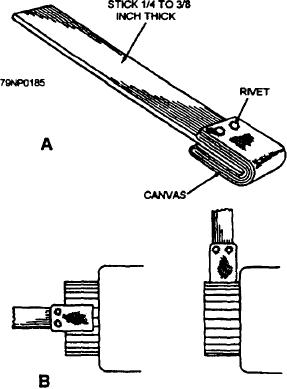
COMMUTATORS AND COLLECTOR
RINGS (SLIP RINGS)
After being used about 2 weeks, the commutator of
a machine should develop a uniform, glazed,
dark-brown color on the places where the brushes ride.
If a nonuniform or bluish-colored surface appears,
improper commutation conditions are indicated.
Periodic inspections and proper cleaning practices will
keep commutator and collector-ring troubles at a
minimum.
CLEANING COMMUTATORS AND
COLLECTOR RINGS
One of the most effective ways of cleaning the
commutator or collector rings is to apply a canvas wiper
while the machine is running. You can make the wiper
by wrapping several layers of closely woven canvas
over the end of a strong stick between one-fourth and
three-eighths inch thick (fig. 7-15, view A). Secure the
canvas with rivets, and wrap linen tape over the rivets
to prevent the possibility of them coming in contact with
Figure 7-15.--Cleaning commutator or collector rings.
the commutator. When the outer layer of canvas
becomes worn or dirty, remove it to expose a clean layer.
paper, or emery stone on a commutator or collector ring
The wiper is most effective when it is used frequently.
since the danger of causing electrical shorts exists.
On ship's service generators, it may be desirable to use
the wiper once each watch. When using the wiper,
TRUING COMMUTATORS AND
exercise care to keep from fouling moving parts of the
COLLECTOR RINGS
machine. The manner of applying the wiper to a
commutator is illustrated in figure 7-15, view B.
With proper care and maintenance, commutators
and collector rings can be counted on to provide years
When the machines are secured, you can use a
of carefree service. If not maintained properly,
toothbrush to clean out commutator slots. You can use
commutators and collector rings may be subject to any
a clean canvas or lint-free cloth for wiping the
number of problems including excessive threading,
commutator and adjacent parts. Besides cleaning by
grooving, copper drag, excessive out-of-roundness,
wiping, periodically clean the commutator with a
waviness, high bars, high mica, slot or pitch patterns,
vacuum cleaner or blow it out with clean, dry air.
contaminated surface films, and so forth.
Do not sandpaper a commutator if it is operating
When any of these symptoms is encountered, the
well, even if long service has developed threading,
most efficient and economical course of action usually
grooving, pits, burn areas between bars, longitudinal
is to begin corrective maintenance immediate y, rather
irregularities, etc., unless sparking is occurring or the
than wait for the condition to get worse. It is desirable,
brushes are wearing excessively. In sanding a
however, to know the history of the machine before
commutator, use a fine grade of sandpaper (No. 0000 is
performing corrective maintenance. For example, light
preferred, but in no case coarser than No. 00). You can
use sandpapering to make emergency reduction of high
threading, small pits, longitudinal irregularities or wide
mica or to polish finish a commutator that has been
slots between bars made during undercutting usually
indicate a need to resurface a commutator or collector
stoned or turned. The sandpaper, attached to a wooden
ring in place. However, if there is no sparking, brush
block shaped to fit the curvature of the commutator, is
wear is normal, and these abnormalities have developed
moved slowly back and forth across the surface of the
over along period of time, no corrective action need be
commutator while the machine is running at moderate
taken. Often, the best maintenance is to leave a well
speed. Rapid movement or the use of coarse sandpaper
running machine alone.
will cause scratches. Never use emery cloth, emery
7-13

